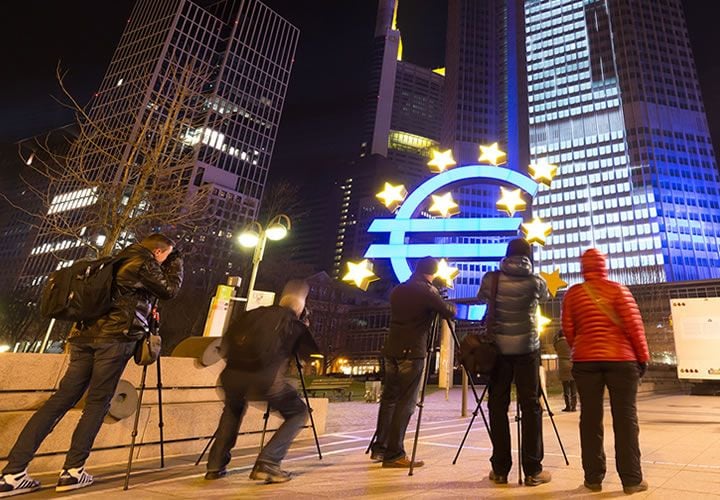"Embrace the Strong Euro" say ING, Forecast EUR/USD at 1.30 in 2018
- Written by: James Skinner
-

A cinematic death of Eurozone breakup risk, the second leg of ECB tapering and speculation of an interest rate rise could all drive the Euro higher in 2018 say analysts.
Companies and individuals dealing in foreign currency should “embrace the strong Euro”, according to strategists at ING Group, as the common currency’s rediscovered momentum will be a defining feature of the 2018 year for currency markets.
In the wake of 2017’s elections in France and the Netherlands Eurozone breakup risk is close to becoming a thing of the past and, with the passing of Italy’s election in early 2018, will fall further from the agenda of investors.
Meanwhile, economic growth has strengthened across the Euro area, enabling the European Central Bank to begin thinking about winding down its quantitative easing program. These themes are expected to continue largely undisturbed during 2018.
The ECB will remain a key driver of the Euro in 2018, with the winding down of its stimulus program likely to occur in two distinct stages, the latter of which will have a sizeable impact on the Euro in the year ahead.
“The Euro has changed and we should embrace it. It is no longer priced as a tail risk currency. With ECB policy normalisation at its start, there is plenty of upside,” says Petr Krpata, an analyst with ING Group, writing in the bank’s 2018 foreign exchange outlook.
The EUR/USD exchange rate has gained close to 13% in 2017 and nearly 4% against Sterling, which partly reflects earlier weakness in the US and UK, but also underlines the scale of the shift in fortunes the currency bloc has undergone in the year to date.
Above: EUR/USD at daily intervals. Captures 2017 advance by the Euro and Dollar weakness.
France’s election of Emmanuel Macron to the Presidency and the Netherlands having eschewed its own pivot toward political disruption can be credited with much of the 2017 improvement in sentiment toward the Euro.
In keeping with this pattern, Italy’s election in the early part of 2018 could also deliver the currency another sizeable boost.
The date of this last remaining political risk event in the current calendar is not yet fixed however, campaigning has already begun and it will almost certainly take place before the end of May 2018.
Italians face a three-way choice. They can choose between a continuation of the status quo, in the form of the current centre-left coalition, or they can opt for a centre-right coalition (Silvio Berlusconi) that offers a similar continuation, but with some more bellicose and populist rhetoric on the side.
Or Italians can vote for a disruption of the established order entirely, and a possible referendum on the Euro, by backing the 5 Star Movement (M5S) in sufficient measure to propel them to a majority in both Italy’s chambers of parliament.
“With bund yields still very compressed and likely to remain compressed until the Italian elections in March 2018 (as was the case ahead the French Presidential elections earlier in 2017), there is room for a possible bund tantrum-like price action and a higher Euiro,” Krpata writes.
Krpata’s base case is obviously that the latter possibility is avoided, which is not a new idea. An M5S government is broadly seen as the least likely option given recent changes to electoral laws that favour coalitions and M5S’s own aversion to entering into coalition agreements.
Above: EUR/USD shown at weekly intervals. Captures QE-related decline from late 2014.
“While we think the bulk of the ECB QE taper expectations is already in the EUR price, still we look for the very last leg of QE taper-led EUR strength in 2Q-3Q18 as the ECB decides on the future of QE either at the June or July policy meetings,” Krpata writes, referring to the next likely bout of Euro strength after the Italian relief-rally.
The European Central Bank is set to reduce the scale of its monthly bond purchase from €60 billion to €30 billion in January and, it is hoped, will sign off on a complete wind-down of the program some time just before or after September 2018.
“The sooner QE ends, the sooner the market will position for the second (not yet priced in) leg of the ECB policy normalisation – the rise in the ECB deposit rate (which is now the relevant policy rate given the excess liquidity generated by the QE),” says Krpata.
ING’s economists say the ECB will most likely extend its quantitative easing by an additional quarter from September 2018, but run the purchases at a further-reduced rate of €15 billion per month until the program’s closure at the end of 2018.
“Our economists expect a first depo rate hike (by 20bp) around mid-2019 and the depo rate to reach zero by end-2019. However, as was the case with the ECB QE tapering, the FX market is likely to position for/price in the deposit rate normalisation well ahead of the event,” says Krpata.
The deposit rate Krpata writes of is currently set at -0.4%, deep in negative territory, which means the ECB currently charges banks 0.4% to deposit funds with it overnight. The minimum bid rate, the main Eurozone interest rate, is set at 0%.
“With the 2yr Schatz yield currently trading at -0.70%, it clearly shows that the scope for re-pricing (and thus higher EUR) is immense, causing the second discrete jump in EUR/USD higher and bringing EUR/USD towards the 1.30 level next year,” says Krpata.
ING’s year-end forecast for the Euro-to-Dollar rate in 2018 is 1.30, its highest level since September 2014 - before the beginning of Eurozone quantitative easing.
Get up to 5% more foreign exchange by using a specialist provider by getting closer to the real market rate and avoid the gaping spreads charged by your bank for international payments. Learn more here.
